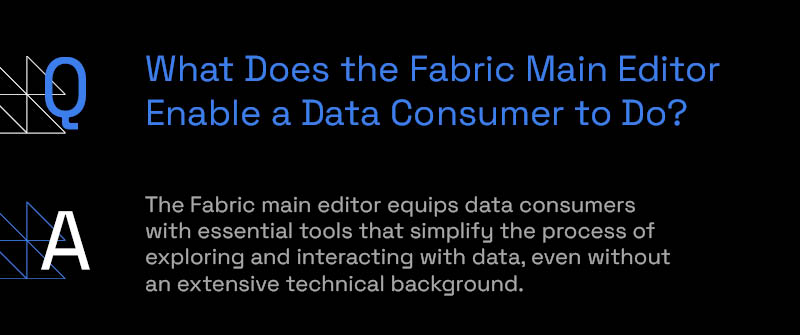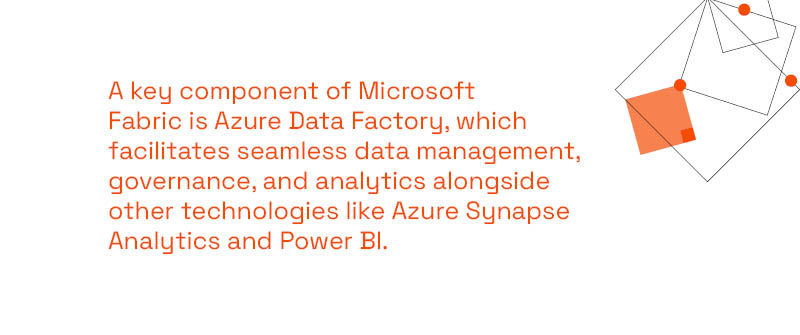
Introduction to Microsoft Fabric
In the fast-paced domain of data analytics, Microsoft Fabric emerges as more than just a data platform; it is a pivotal force for unifying data, analytics, and AI to enhance decision-making and drive substantial business growth. By optimizing data handling and analysis, it provides a seamless environment for addressing all data analytics needs, enabling organizations to leverage data as a strategic asset in a cohesive and integrated manner. This approach is often guided through Microsoft Fabric consulting services, ensuring tailored solutions that maximize the value of enterprise data.
Unleashing Business Analytics with Microsoft Fabric
Microsoft Fabric stands as a cornerstone for modern data analytics, revolutionizing how businesses collect, store, and interpret data. Consolidating diverse data sources into a unified architecture reduces the complexities of data management and unifies various data workflows involved in data handling. This shift enables companies to move from merely handling data to extracting actionable insights, fostering a competitive edge. Additionally, streamlined data integration plays a critical role in enhancing analytics and reducing operational costs. Its scalable design serves enterprises of all sizes, offering solutions that align with the specific demands of each organization.
Navigating Microsoft Fabric’s Evolution
The introduction of Microsoft Fabric marks a transformation in data analytics, responding to the need for more adaptive and integrated platforms. Integrating Microsoft Fabric into a comprehensive data strategy is crucial for businesses aiming to optimize data management and analysis. Launched with advanced technology, it enhances the speed and efficiency of data utilization. With a focus on compatibility and scalability, Microsoft Fabric integrates smoothly with existing systems, optimizing investment while minimizing the usual challenges associated with new software. This showcases the power of Microsoft in driving innovation and enabling organizations to harness real-time data for better decision-making.
Strategic Architecture of Microsoft Fabric
The architecture of Microsoft Fabric supports advanced analytics and AI functionalities, positioning it as a leader in data-driven business landscapes. It offers a user-friendly interface that promotes adoption across various departments and user levels. Acting as a central hub for data activities, it simplifies data handling and encourages innovation by making analytics accessible to a broad audience. Additionally, Fabric data analytics plays a crucial role in building, deploying, and operationalizing machine learning models, integrating seamlessly with Azure Machine Learning for enhanced predictive insights.
For business leaders strategizing growth or IT professionals implementing complex data systems, Microsoft Fabric provides the versatile and scalable framework essential for transforming data into a powerhouse of innovation and strategic planning. Understanding its architecture and role in analytics underscores its significant role in driving digital transformation, supporting a strategy to make data central to business success. Fabric data engineering is integral in creating and managing infrastructures for processing and analyzing large volumes of data, empowering business analysts and data engineers to collaborate efficiently and streamline data pipeline development.
What Are the Benefits of Microsoft Fabric?
When it comes to achieving business growth through technology, leveraging tools like Microsoft Fabric can be a game-changer. Business analysts can leverage AI and data management tools within Microsoft Fabric to access insights from pre-built AI models and collaborate with data engineers. The benefits of Microsoft Fabric are plenty, providing a robust infrastructure for organizations aiming to boost their data-driven strategies. With its unparalleled scalability and seamless integration, Microsoft Fabric empowers businesses to harness the full potential of their data assets, driving substantial growth and competitive advantage by utilizing sophisticated data pipelines that facilitate rapid development cycles and enhance team agility.

Scalability and Integration Capabilities
The ability to scale as your business grows is crucial, and Microsoft Fabric is designed with this necessity in mind as a comprehensive data platform. Its scalable architecture ensures that your data infrastructure can grow alongside your organization while avoiding the typical pitfalls of increased complexity and cost. Additionally, Azure SQL Database plays a key role in supporting data integration and operational databases, facilitating seamless replication of data across various systems into OneLake. Furthermore, Microsoft Fabric’s superior integration capabilities allow businesses to connect disparate data sources across their enterprise, creating a cohesive data environment that streamlines processes and improves decision-making. This flexibility is especially beneficial for enterprises that require adaptable solutions to meet evolving demands in the dynamic business landscape.
Enhancing Data Accessibility and Decision-Making
One of the primary advantages of Microsoft Fabric is how it democratizes data access. By bridging traditionally siloed data compartments, it delivers a unified data structure that ensures every stakeholder can access valuable insights when they need them. By integrating with Microsoft 365, Fabric allows users to easily access and utilize relevant data from OneLake across various applications like Excel, Teams, and PowerPoint, thereby enhancing decision-making. Consequently, decision-making becomes more efficient and informed, facilitating a culture of quick responsiveness and innovation within the organization. Enhanced data accessibility also fosters an environment where data becomes an integral part of daily business functions, thus promoting a proactive approach to strategy formulation and execution. Additionally, the inclusion of real time analytics enables prompt decision-making and operational efficiency, streamlining the analytics process within unified ecosystems like Microsoft Fabric.
The Democratization of Data Analytics
Microsoft Fabric takes the democratization of analytics a step further by providing user-friendly interfaces and tools that allow non-technical users to perform complex analytical tasks. By consolidating various data processes into a single platform, Microsoft Fabric promotes efficient business intelligence. This capability empowers business leaders and teams, irrespective of their technical acumen, to partake directly in data interpretation and strategy alignment, driving a more inclusive approach to data culture. By allowing widespread access and interaction with data analytics, Microsoft Fabric contributes significantly to nurturing a data-driven ethos across the organization.
Overall, the introduction of Microsoft Fabric into the business strategy equation means businesses are well-equipped to leverage data as a catalyst for growth, creating a significant return on investment both in terms of data efficiency and strategic foresight. It’s time to seamlessly transition to a more intelligent and actionable data infrastructure model, and there’s no better way to do so than with Microsoft Fabric. We at P3 Adaptive specialize in guiding businesses through this transformation, ensuring you extract the utmost value from your data by helping to simplify data processes.
What Does the Fabric Main Editor Enable a Data Consumer to Do?
The Fabric main editor equips data consumers with essential tools that simplify the process of exploring and interacting with data, even without an extensive technical background. Business users can leverage the Fabric main editor to easily access and analyze data for informed decision-making. Serving as a bridge between complex datasets and actionable insights, it allows users to craft visual stories from raw data, thereby democratizing data analysis and enhancing collaborative efforts across varied user roles.

Simplified Data Navigation for Business Leaders and IT Professionals
With its intuitive interface, Fabric main editor empowers business leaders and IT professionals to navigate seamlessly through data. This functionality minimizes dependency on specialized data teams for routine analysis, enabling users to transform simple figures into compelling visual narratives. This approach facilitates a deeper understanding and promotes smarter decision-making rooted in data.
Exploring and Interacting Without Technical Barriers
Designed to dismantle the barriers to data exploration, the Fabric main editor grants access to data insights for users regardless of technical proficiency. Users can delve into datasets, experiment with visual representations, and uncover hidden insights, fostering a culture of creativity and innovation. The platform encourages users to probe, question, and derive meaningful interpretations without the necessity for coding.
Artistic Transformation of Data into Visual Narratives
One of the standout features of the Fabric main editor is its ability to convert complex data into clear, visual narratives. Users can transform dense data structures into engaging story-like visualizations, akin to converting a detailed novel into an engaging comic strip. This process not only clarifies insights but also aids in aligning teams by establishing a cohesive narrative that supports strategic planning.
Enhancing Collaborative Efforts Across User Roles
The collaborative capabilities of the Fabric main editor are significant. By facilitating simultaneous data interaction among multiple users, the platform boosts teamwork and the exchange of ideas. Users from various roles, ranging from business managers to IT specialists, can engage with the data in real time, ensuring that insights extend beyond data teams and are accessible organization-wide, fostering informed collective decision-making.
Leveraging these capabilities of Microsoft Fabric, organizations can unlock new potentials for data-driven growth. At P3 Adaptive, we assist businesses in maximizing the utility of innovations like the Fabric main editor, ensuring they stay ahead in today’s competitive landscape. By providing guidance and support for various analytics tasks, the Fabric main editor enhances productivity for both data professionals and citizen developers, enabling the efficient creation of complex models and queries.
Microsoft Fabric vs Power BI and Databricks
For business leaders and IT professionals seeking to optimize their data analytics pipeline, the choice between Microsoft Fabric vs Power BI and Databricks entails evaluating their unique capabilities tailored to different needs. Microsoft Fabric stands out as a comprehensive analytics platform that integrates multiple data and analytics tools into a single, unified system. Each tool plays a pivotal role, yet each serves distinct functions in the landscape of data management and analytics.
A key component of Microsoft Fabric is Azure Data Factory, which facilitates seamless data management, governance, and analytics alongside other technologies like Azure Synapse Analytics and Power BI.

Comparative Analysis of Functionality and User Applicability
On one hand, Microsoft Fabric acts as a comprehensive analytics powerhouse, integrating various processes from data intake to visualization. Its suite encompasses elements like the Lakehouse, which merges traditional databases and data lakes for efficient storage and processing. Additionally, data warehousing plays a crucial role in managing both structured and unstructured data, enhancing SQL-based management suited for traditional database development. Meanwhile, Power BI is renowned for its user-centric capabilities in transforming raw data into actionable visual narratives. Power BI provides unparalleled ease of use for creating dynamic reports and dashboards, making it ideal for end-users who prioritize interpretation and presentation. Databricks, alternatively, specializes in big data analytics, offering robust capabilities for machine learning and processing large-scale datasets, making it an invaluable tool for extensive data science applications. Data analysts can leverage these tools to derive valuable insights and inform decision-making in a competitive market.
Integrated Capabilities with Existing Tools and Ecosystems
The strength of Microsoft Fabric lies in its ability to seamlessly integrate with existing Microsoft tools, enhancing productivity and reducing the learning curve associated with adopting new technologies. Azure Synapse Analytics plays a crucial role in facilitating data analytics and machine learning within this integrated environment. It complements Power BI by bolstering back-end data processing and management, thereby setting a solid foundation for Power BI’s interactive capabilities. Databricks, while also offering integration with Azure, focuses more on collaborating with data engineering and machine learning frameworks, providing high-value support for technical data teams focusing on innovation and complex computations. Additionally, utilizing a unified data lake within these platforms reduces data duplication, enhances accessibility, and streamlines the process of creating analytics and reports.
Addressing Specific Business Needs with Each Platform
Choosing the right tool often comes down to specific business needs and objectives. Microsoft Fabric is highly suited for organizations needing an all-inclusive solution that covers end-to-end data processes from ingestion to visualization. Data scientists leverage advanced tools and diverse datasets within this platform to perform analyses that drive operational efficiency and strategic insights, particularly in applications like AI and machine learning. It’s ideal for those already enmeshed in Microsoft’s ecosystem. Power BI is perfect for enterprises focused primarily on data representation and ensuring their teams can independently generate insightful visualizations without deep technical expertise. On the contrary, if an organization finds itself tackling extensive data sets requiring sophisticated computational power and machine learning models, Databricks emerges as the optimal choice.
In summary, the decision should weigh heavily on the business’s data volume, the complexity of analytics, and the dependency on real-time decision-making insights. By certifiably leveraging these platforms with P3 Adaptive’s assistance, businesses can ensure they select the tool that not only integrates seamlessly into their workflow but propels them toward their strategic goals with comprehensive data solutions.
The Future and Pricing of Microsoft Fabric
The evolution of data analytics platforms is set to reach new heights with Microsoft Fabric, heralding a future where data-driven strategies become fundamental to competitive business advantage. By consolidating data analytics processes onto a unified platform, Microsoft Fabric can lead to significant cost savings for businesses. Microsoft Fabric’s continued development is aimed at breaking barriers that currently impede analytics and AI projects, setting the stage for transformative business operations that harness the power of data like never before, effectively addressing modern data challenges.

Positioning Microsoft Fabric in Future Tech Landscapes
Microsoft Fabric is poised to redefine how businesses engage with data as a unified platform. As technology continues to advance, Microsoft Fabric’s integration capabilities ensure it remains at the forefront of the data analytics landscape. The platform’s ability to consolidate various data sources across a single AI-powered platform not only enhances efficiency but also provides businesses with genuine strategic value, making it indispensable for those looking to navigate the future digital landscape.
Understanding the data landscape in relation to Microsoft Fabric is crucial for optimizing data flows and decision-making, positioning it as a critical tool for companies aiming to innovate and thrive in a data-driven environment.
In addition, its AI-enhanced capabilities offer predictive insights and trend identification, positioning businesses to be proactive rather than reactive.
Understanding Pricing Models and Their Implications
In terms of pricing, Microsoft Fabric pricing is as strategic as its technology. Offering both a flexible Pay-as-you-Go model and Reserved Instances, Microsoft Fabric adapts to the unique economic environments of businesses of all sizes. This flexibility ensures that organizations only pay for what they need while still giving them the potential to scale operations as the business grows. The cost efficiency of these pricing models simplifies collaboration and speeds up processes by integrating various data-management components within a single environment. Whether opting for the more dynamic pay-as-you-go structure or the stable reserved instances model, businesses can tailor their engagement with Microsoft Fabric according to both present demands and future growth projections, optimizing cost for maximum effect. Integrating data storage into a cohesive platform enhances data management and operational efficiency, making it a valuable asset for organizations.
Potential ROI and Strategic Business Value
The strategic business value of integrating Microsoft Fabric into organizational systems is extensive. By streamlining data operations, Microsoft Fabric reduces overhead and enhances data-driven decision-making. By unifying data analytics and leveraging AI capabilities through the platform, businesses stand to achieve significant ROI. The transformative potential of Microsoft Fabric lies in its capacity to reduce the complexity of data processes, enhance cross-functional insights, and facilitate decision-making based on comprehensive data understanding. The streamlined analytics available through Microsoft Fabric translate into real-world savings and opportunities for innovation, driving improved business outcomes and opening new avenues for growth by alleviating the burdens of data architecture.
Conclusion
Concluding our review of Microsoft Fabric, it’s evident that this platform transcends being a mere tool within the Microsoft ecosystem. At its essence, Microsoft Fabric supports organizations in achieving significant business impacts through its advanced data management and analytics capabilities. By consolidating data resources and eliminating data silos, it ensures that data-driven decision-making moves beyond possibility to optimized reality.
Comprehensive data solutions are crucial for businesses with existing cloud infrastructure, and Microsoft Fabric enhances data integration and analytics capabilities.

Microsoft Fabric’s real strength lies in unifying data practices, creating an environment where insights drive core business strategies. This shift not only fuels growth but also aligns with leveraging technology for a sustainable competitive edge. Moreover, investing in Microsoft Fabric certification equips your team with expert knowledge, empowering them to navigate the complex landscape of data initiatives confidently.
The Role of Microsoft Fabric Certification
Grasping the subtleties of Microsoft Fabric is essential for IT professionals and business leaders aiming to leverage its full capabilities. Achieving certification offers more than recognition; it demonstrates a profound operational understanding of the platform. Certification also enhances productivity for data professionals by providing guidance and support for various analytics tasks. Certified individuals, including data engineers, can manage data projects with assured precision and deliver significant ROI.
In today’s ever-changing digital landscape, a strong command of Microsoft Fabric can be the differentiator between excelling and merely coping. Certification enhances your team’s competencies, positioning them for effective strategic data interventions.
Advancing Data-Driven Decision-Making for Growth
Promoting data initiatives is at the heart of uncovering new opportunities. In today’s competitive business environment, making data-driven decisions is crucial for success. Microsoft Fabric provides the necessary tools to streamline this process, enabling teams with intuitive engagement with data. Utilizing these features equips businesses to operate with agility, making informed decisions swiftly and accurately.
Integrating Microsoft Fabric goes beyond an upgrade; it represents a transformative shift with considerable benefits. Transform your business with guidance from consulting services that expertly embed Microsoft Fabric’s analytical capabilities into your operations. Embrace a data-centric approach that eradicates inefficiencies and positions your organization for enduring growth in today’s evolving technological landscape. Microsoft Fabric addresses modern data challenges by simplifying data integration and enhancing analytics capabilities.
Get in touch with a P3 team member